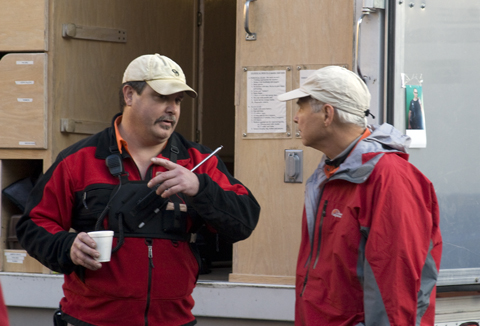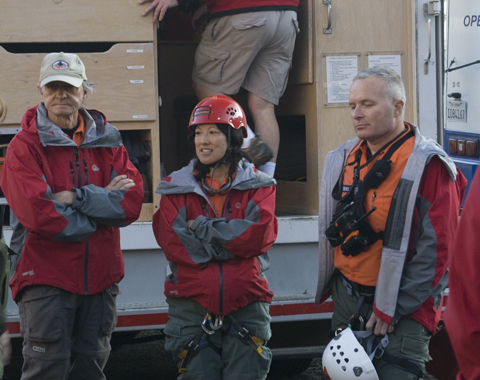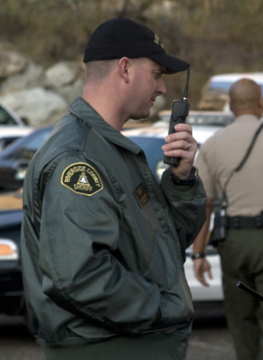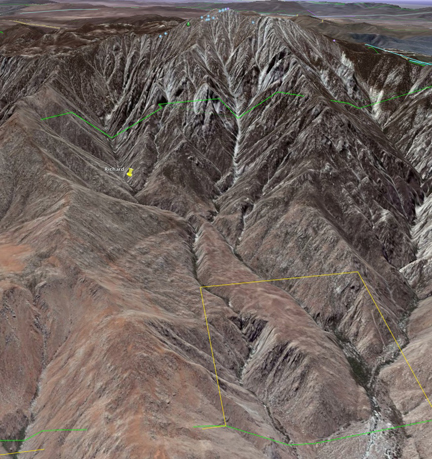Missing Hiker, San Jacinto Wilderness
|
November 9, 2007 |
By Patrick McCurdy
Day 1
A lone hiker, Richard Harper, was reported missing Friday when he did not return from a hike on Thursday. RMRU searched all afternoon and into the night for him in the area above and below the upper station for the Palm Springs Tram. Jim Manues and I were flown into and out of an assignment on the Skyline Trail and I left about 10 p.m. to get some sleep, as we were already planning a big ramp-up for the search for the following day with many people coming in from out of county SAR teams.
Day 2
After about 4 hours of sleep I drove back out to the tram to help get the sheriff's command post running and to get our operations section ready for a lot of search crews coming in. After a few hours we had sixteen field teams deployed and an amazing six aircraft either in service or expected shortly. After our own sheriff's Star 93 helicopter had finished inserting search crews on the mountain, I got in to fly as an observer. Our assignment was to fly the infamous north face of Mount San Jacinto, one of the tallest escarpments in the country.
Just as we got off the ground I switched from my helmet to an intercom headset which allows me to talk to the flight crew. The pilot, Tony Bowen, asked me if I had heard the latest radio traffic. The U.S. Forest Service had reported a small fire in the Snow Creek drainage, an area we were supposed to search anyway, so we headed there first. Within minutes of entering the drainage we could see a small column of smoke and almost immediately Tactical Flight Officer Chad Marlatt calmly said "There he is."
Richard was on a very steep, rocky canyon wall, very close to a small fire, and waving his arms over his head. Tony flew in closer to check out the situation while Chad got on the PA and told the guy repeatedly to put out the fire and that we would be right back.
This was not a good location for a helicopter operation. Winds were difficult, the canyon wall was very steep, and there was no way to put the helicopter down near him. Richard could not really move anywhere as there was fire below him and steep rock above. Tony asked me if I was equipped for a hoist, which I was.
We flew to a nearby hill where Tony could set the helicopter down. Chad got on his harness (so he could stand on the side skid while hoisting me in and out of the bird), rigged the hoist, and gave me a quick refresher on a sling device called a Bauman Screamer Suit that you put on the subject like a very loose, sleeveless straightjacket. I decided there was little use in taking my pack down the hoist as there would be no time for a medical assessment. If he was standing and waving his arms, he was healthy enough to be hoisted, and the rotor wash would have fanned the flames of the fire meaning we needed to get this done quickly.
When we got back to him 5-10 minutes later, the fire had grown. Chad handed me the hook from the hoist, but told me to stay inside the bird as Tony carefully edged the bird in close enough to put me down on the rocks where Richard was standing rather than into the fire. Odd canyon winds and the closeness of the canyon wall to the rotors made this very dicey flying. Finally Chad signaled me to get out on the skid and quickly had me descending to the subject.
The helicopter hovering overhead had beat down the flames, but it was fanning the coals and I could feel the heat of the fire as I descended. Richard started grasping at me as I got down close to him, but I signaled him to stand back - footing was going to be tough enough without someone grasping at my legs. When the hoist cable had enough slack in it to put me down, I finally got my footing on the steep rock, unhooked the hoist from my harness, and signaled Chad I was off-hook so Tony could back the bird away from the canyon wall.
I turned to Richard and asked him how he was doing. He was in tears and sobbing, physically scratched up pretty badly, but otherwise not apparently injured. He was an emotional wreck, repeatedly telling me he had thought he was going to die. It was about then that I heard a big whoosh-crackle-crackle-crackle. I turned around to see 10-15 foot flames about 30 feet away. Oh, man. That scared me. The rotor wash had heated up the coals and embers and, when Tony pulled the bird away, the fire had found new fuel and had taken off. I looked around, but there was nowhere to go - fire on one side and steep rock on the other. We had to get out of there fast.
I got Richard into the harness and signaled Chad I was ready. Tony brought the bird back in and Chad guided the hoist hook to me as the rotor wash blew ash and hot embers at us. I snapped the hook onto the harness, signaled "ready for lift," and Richard was on his way up. Tony backed the bird off again so Chad could get Richard in the bird and situated. This took a couple of minutes and the fire kicked up even more. I again looked for someplace to go, but was basically stuck where I was. All I could think of was "Oh, please don't leave me here, boys!"
Tony then brought the bird back in and Chad had a little difficulty getting the hoist hook to me because of the wind, but I was fairly quickly on the hook and off the ground. When I got into the bird and we were headed back, I checked on Richard and he was still sobbing and emotional, but grateful to be rescued. We landed back at the command post a few minutes later and Richard was transfered to a waiting ambulance, then to a local hospital.
It took hours to fly all of the other search teams out of the field, as they were scattered all over the San Jacinto Wilderness from the tram, to Little Round Valley, to Saddle Junction, to Caramba, with numerous teams near the peak and over the north face of San Jacinto Peak. Given his emotional condition and state of exhaustion, I seriously doubt Richard could have made it out alive on his own.
This was definitely the most exciting (and spooky) thing I've done with the RMRU. I've been hoisted into and out of remote locations before, but I've never hooked up a missing person to be hoisted out. I've no problem with that part of it, but I could quite easily skip the whole fire part of the story next time.
Lessons Learned
In addition to a map, compass, and/or GPS, a few other articles in your day pack can make a big difference.
Even when looking right at Richard from the air, it was hard to make him out from the surrounding rocks and vegetation. This was largely due to his clothing which consisted of a black t-shirt and camouflage shorts. Bright clothes would be ideal, but any brightly colored cloth that you can wave over your head would work to signal an aircraft (see write up for Mission #11 from earlier this year.)
I'm also confident that Richard would now agree that some amount of warm clothing is appropriate to pack even for a day hike in pleasant weather. With temps near freezing for his two nights out, even a light polarfleece sweatshirt and light winds pants would likely have made a huge difference in comfort.
Always plan ahead for every hike. It can make your experience much more pleasant and might just save your life.
The Big Picture
This was a big search and had the potential to get much bigger over the weekend. Riverside Sheriff's SGT Webb and CPL Garvin served as Incident Command. LT Sawicki and Deputy Lanning of the Sheriff's Emergency Response Team (SERT) had their crew bring out multiple motorhome command posts, trailers, and other equipment to supplement RMRU's humble operations truck for the Incident Command Post (ICP), including satellite phones, computers, radios, etc. The SERT Team also coordinated all the support from out of county, including an amazing six aircraft - the most I've seen at any one time on any search.
The Sheriff's Office brought tremendous resources to the search but let RMRU run field operations. A search this big requires a lot of "overhead." These are people who would much rather go into the field searching, but end up serving in a management role in the overall search operation. Steve Bryant served as Plans Chief, Deano Esades was Operations Chief, Jim Bakos served as the Communications Unit Leader, Dana Potts as Logistics Chief, Dr. Ray Hussey ran the helibase, John Dempsey ran communications at the top of the tram, and Dr. Bill Delo served as Command Post Liaison and standby medical support. Nearly every single member of RMRU served either at the ICP or in the field.
In addition to our own team, numerous other volunteer SAR teams assisted in this search. Our friends with Desert Sheriff's Search and Rescue are always the first to be called to help us, but this search also saw assistance from San Bernardino Cave Rescue Team, Rim of The World Search and Rescue, San Diego Mountain Rescue, San Gorgonio Search and Rescue, Palm Springs Mounted Search and Rescue, Central Mountain Search and Rescue, and San Bernardino Mountain Rescue as well as State Parks Rangers and their group of volunteers. Thanks also to the Palm Springs Tramway, which always gives us fantastic support during our numerous missions up there.
Air assets included San Bernardino County Sheriff's Air Rescue 7, CHP's H60, Los Angeles County's Air Rescue 5, and Riverside's own Star 93. Both CHP and San Bernardino had other aircraft en route to the search. Hat's off to Riverside's SERT for getting such an incredible mutual aid response rolling in such a short amount of time.
My own particular thanks to Tony Bowen and Chad Marlatt from Star 93, with whom I flew. We train often with all Riverside Sheriff's pilots and crew. It is due to this training and their expertise that rescues like this one are possible.
News Coverage
Video
Try downloading the video to your computer and watching it there (right-click the link and "save-as" to your local home computer). Our server does not stream video well.
Steve Bryant briefs pilots on their flying assignment.
Richard in Snow Creek Drainage, off the north face of San Jacito Peak.
Richard - Larger, cleaner version of the same video above..
Richard getting out of the helicopter back at the command post.
Photos

Jim "Bill" Bakos and Bill Delo discuss the search

Jim and Grace Manues and Jeff Toscas at the ICP

RSO's Chad Marlatt Coordinates Air Operations

Pilot Tony Bowen
Location where Richard was rescued.
